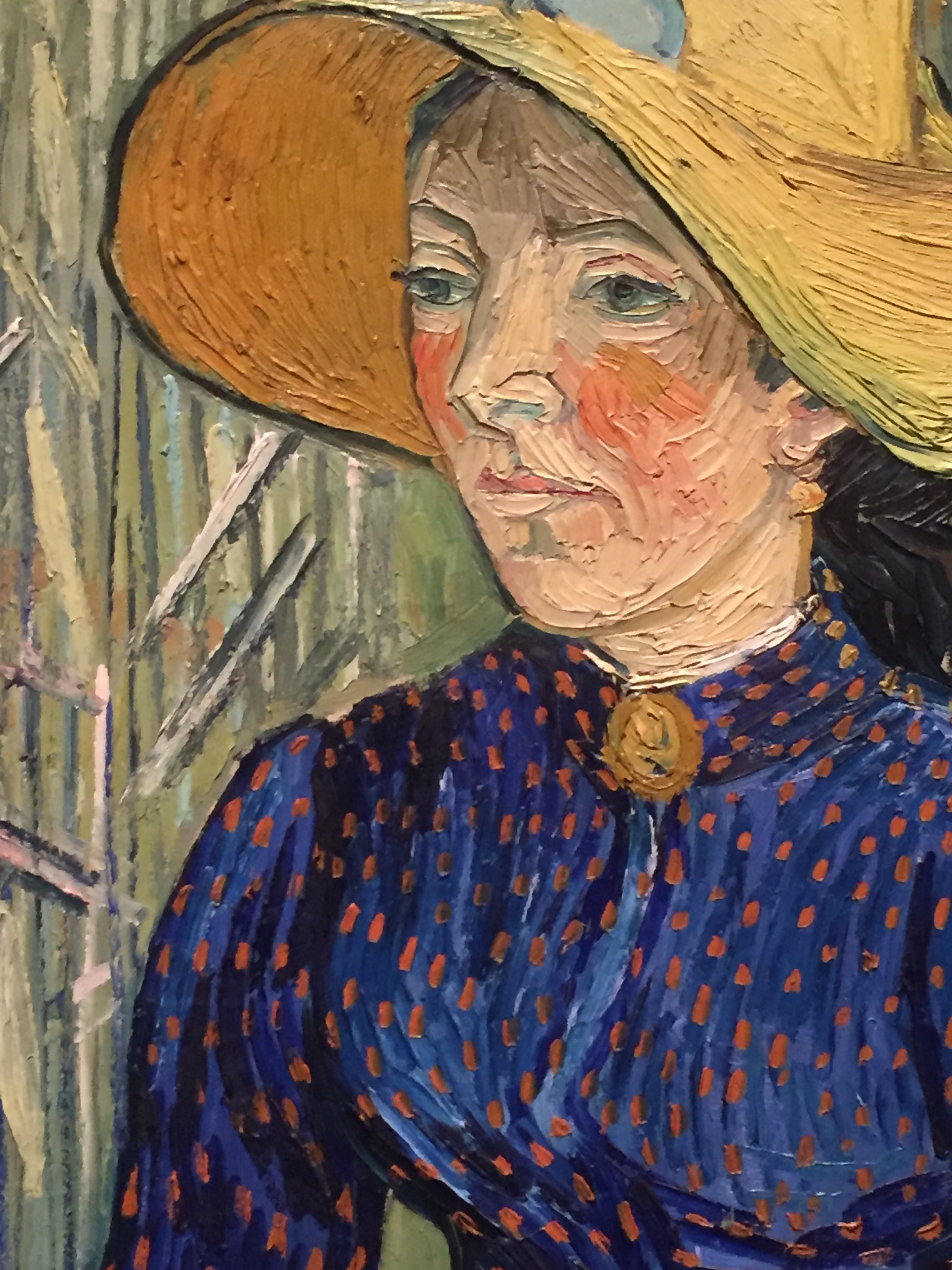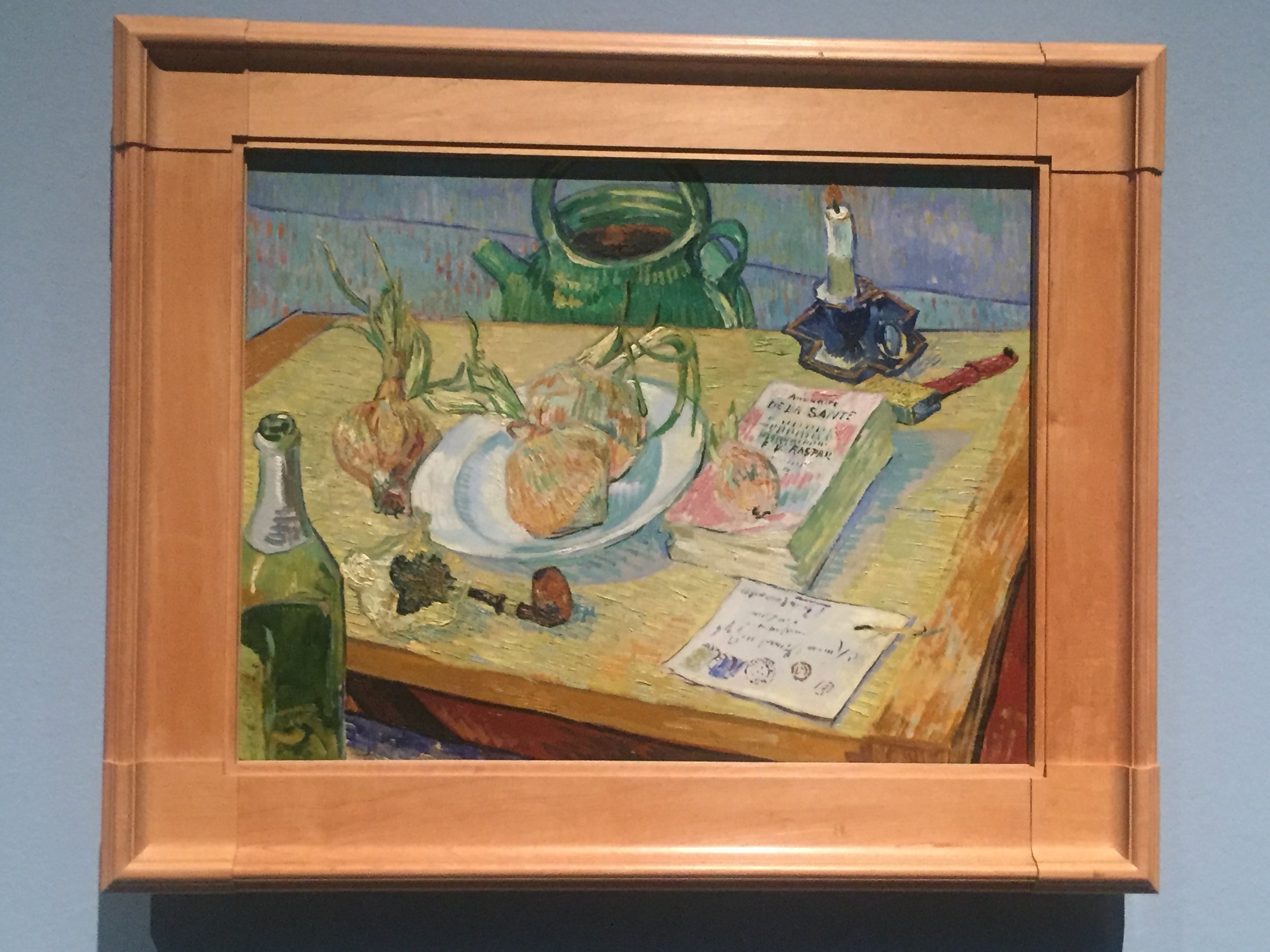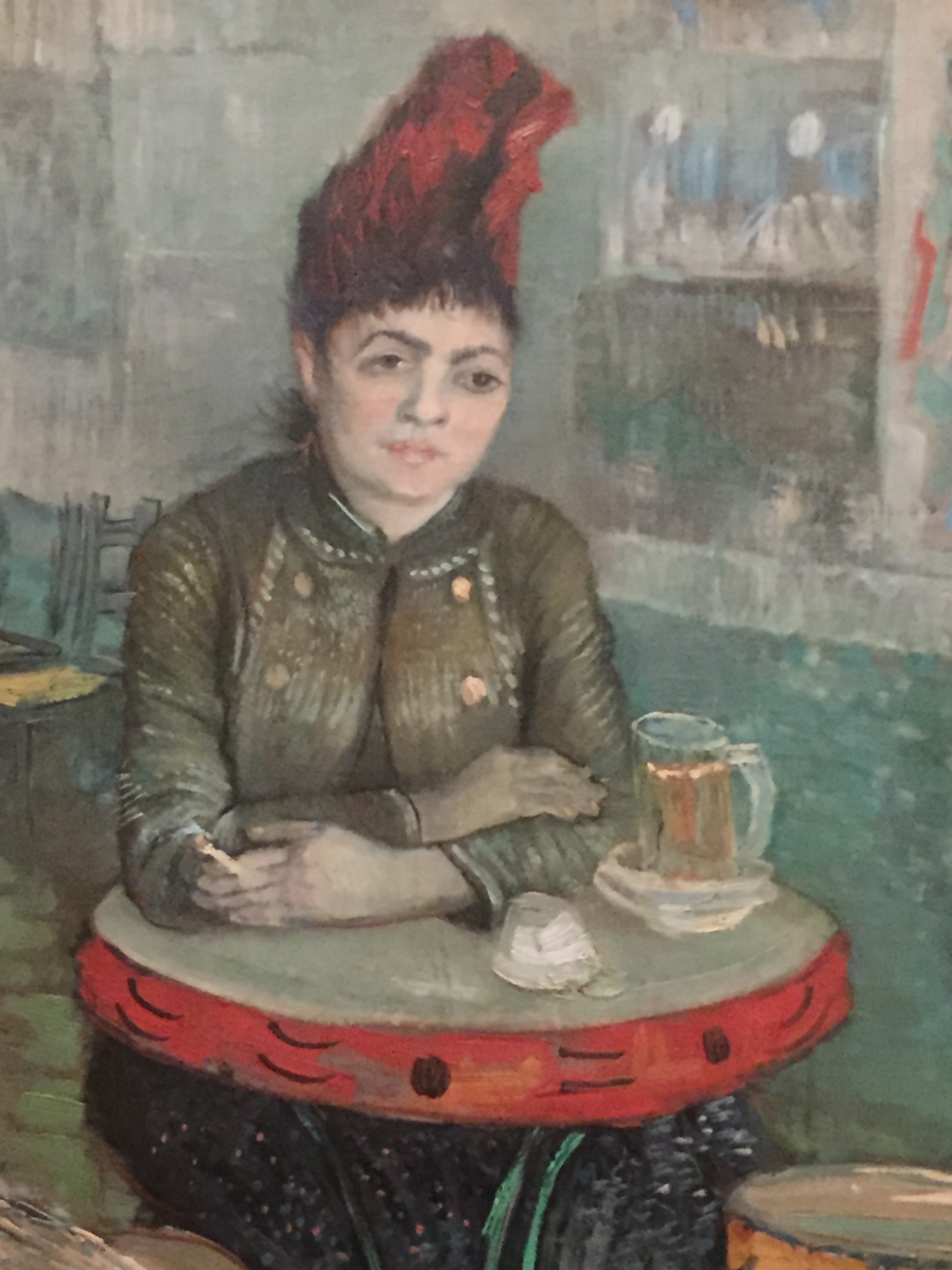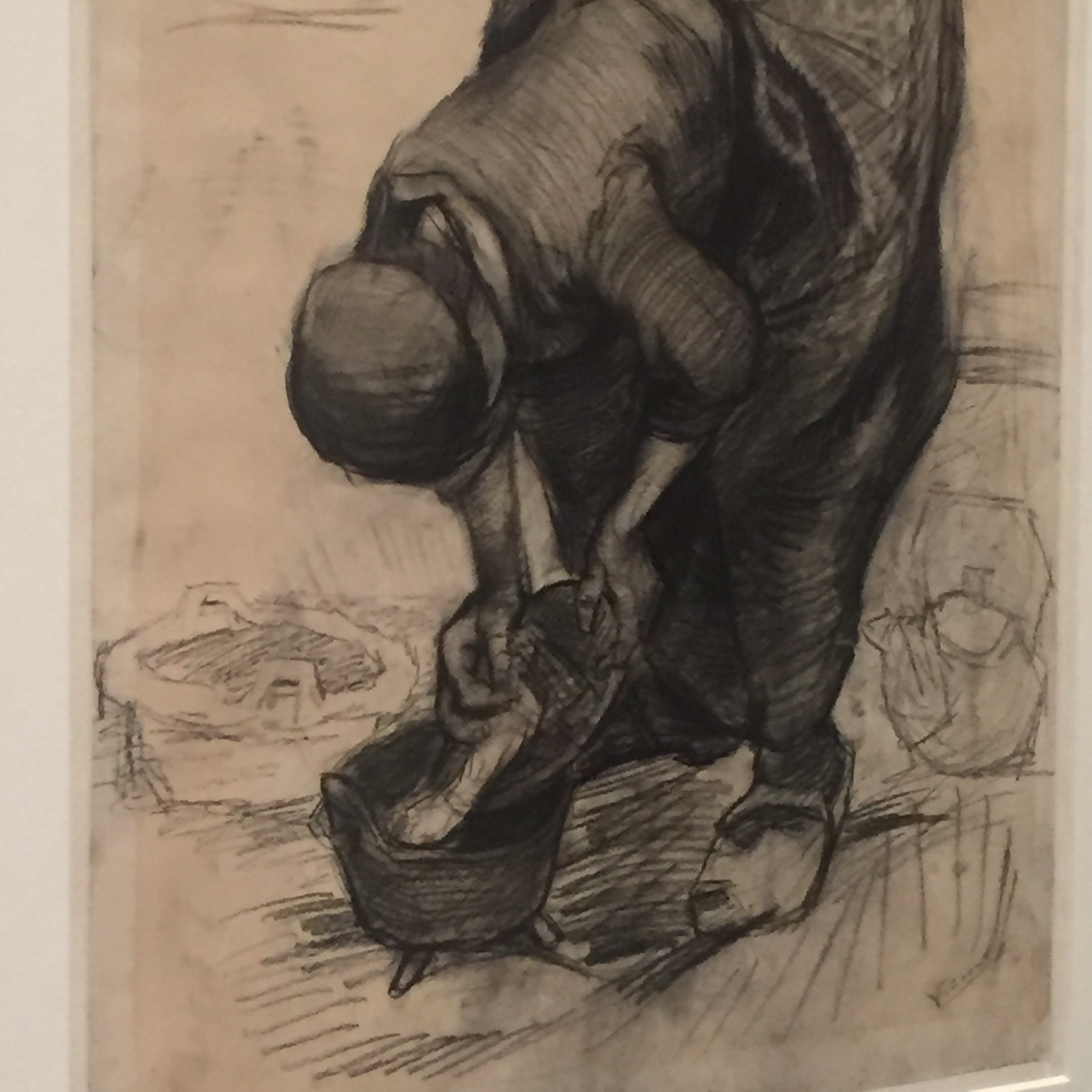This show of Vincent van Gogh in Houston is one of the best Van Gogh shows I’ve seen as far as diversity of work and the message of the show. Not every Van Gogh painting is here, but there are definitely paintings that are rare, less-seen, and drawings that floored me. Starry Night at the MoMA and Self Portrait at the Musee d’ Orsay are probably the two Van Goghs that we think about most, this show gives us reasons to see lesser-known Van Goghs in an iconic way.
Like the following three paintings after Millet:
Detail of the above painting, where the paint isn’t brushed on so much as applied like patches of bricklaying cement:
To this day I don’t know how Van Gogh painted this way. A brush doesn’t lay down color like a trowel, and to do it with a palette knife you’d have to have the patience of a saint. We all know the painting is a lovingly-made replica of one of Van Gogh’s art heroes, Millet, but how, how the heck did Van Gogh do this?
How did he paint like this, with the volume of the paint jutting out from the painting? Brushes press down paint and smooth it out, palette knifes lay down color, but there isn’t a tool in painting that lays down little embossed swatches of paint like the green swatches above. There just isn’t. Whatever Van Gogh was doing, he was using paint in an absolutely new way. He was laying it down and then shaping it, or he was loading his brush for every single stroke, dipping the brush and hitting the canvas, dipping the brush and hitting the canvas, over and over again. This would be an incredibly hard - but rewarding - way to paint.
In paintings like these, copies of Millet’s work of peasants bundling hay, the paint is applied and shifted in a way that would be less maddening. You can see that Van Gogh laid down colors and then shifted them, sculpted them across the canvas, later adding touches of atmosphere like the purplish haze around the hay and sky below.
Van Gogh never saw these peasants but he was often thinking about them. He loved Millet and cherished Tolstoy and ever since Potato Eaters, was more concerned with peasants than most.
Van Gogh had failed at many other courses in life before setting out to paint - he tried to be a teacher, he tried to be a preacher, and didn’t make it at either. While he didn’t succeed at painting financially in his lifetime, his success as a painter eternally stemmed from his habits of hanging up paintings and prints all around him in his rooms, and writing to his brother about paintings and landscapes. In reading Van Gogh’s lettters, I’ve never seen anyone be such a fan of other painters. In one letter to his brother from 1875, he writes a short greeting and then goes on to list all of the paintings he has hanging in his room:
He was studying these paintings like he studied and quoted The Bible in other letters.
When Van Gogh copies Millet or makes a painting ‘after Millet,’ the best we could analogy that we could make for our time is that Van Gogh made unabashed fan art. The paintings above are homages, or fan art, or both.
Like a kid who loves Spiderman so much that he starts doodling, Van Gogh loved Millet so much he wanted to make Millet paintings himself. He was relentless to learn and studied the hell out of painting and kept painting, and didn’t quit even when he got sick.
The book is a homeopathic remedy book. What about the smaller onion that has fallen onto the book’s cover? Did it just fall off, is it hiding something on the cover? Unlike a spread in Oprah, It’s not the most organized scene, but the onion is kind of hiding the book.
The lavender shadow in this painting almost did me in. I’ve never seen such a bright shadow. Though this was a painting of an asylum during Van Gogh’s stay there, it looks like a great place to recover. It looks like this place would heal anything.
It was nice to see The Rocks at this show in different lighting - though in the permanent collection at the MFAH, The Rocks takes on a new light against a darker wall in this exhibition. Typically it’s on the second floor of the museum and is against a lighter wall, though still encased in an ornate golden frame. I was so entranced by The Rocks when I saw it that I wrote a small mini-blog just about this painting, nothing else. Every time I see it in Houston, there’s something new to see. And it’s unlike any other Van Gogh I’ve seen. The sky relishes with broader, more lengthy strokes than other Van Gogh skies. Pink, yellow, blue cross the canvas and lead you to believe in a wind that shakes the dark tree. I believe in the rocks in this piece. Vincent could look at what would otherwise be someone’s throwaway photo and make something iconic out of it.
Vincent had mentioned The Rocks in a letter to Theo, where he complained about dust and wind. Painting en plein air means chaos seeps in from all angles - bugs, dust, wind, time, people walking up to you and asking you about art - all of these are challengers to making a painting outdoors.
Limited time does compress talent in a good way - you have to see accurately and replicate quickly, before the wind throws dirt into your skies.
In many Van Gogh paintings you can tell when he has acquired a new paintbrush - in the painting of a wheat field above, he has a larger brush by far than in other works and isn’t afraid to set it to work in the sky and foreground, where the smaller details are worked in the strip of trees in the horizon. The painting above could have been made with the staccato, small brushstrokes of Starry Night, but instead, more generous knifings of paint complete the atmosphere.
I’d never heard the story of the painting above, or seen the painting. If you’d asked me on who had made this painting I would have said an early Manet, maybe Lautrec on a weird day, someone else, but not Vincent van Gogh.
The painting depicts woman that Van Gogh was seeing at the time. He may have painted her right there or sketched her and painted her later, but either way, boy she looks glum. She looks like she’d rather be anywhere else.
According to the placard, the relationship later took a ‘stormy’ turn. Beer in one hand and cigarette in the other, this is how you get through dating Vincent Van Gogh.
(Okay, maybe that’s not beer, but it sure looks like beer)
The thought is that Van Gogh must have been too much for most people - committing himself to asylums, getting in fights with Gauguin, rejection after romantic rejection, failed jobs, living with his parents at age 30 … people just couldn’t really stand him after a while. But who knows? Maybe we’re looking at a guy who had a lot of the same problems that guys (and gals!) in their 20s have, and 150 years later, romance, jobs, and families are mostly the same. He tried to teach, he tried to preach, but painting was what he was meant to do and while Theo was a saint of financial and emotional support, it couldn’t save Vincent.
Speaking of Gauguin, the sitter for the portrait below had been painted by both Van Gogh and Gauguin in one sitting. This isn’t my favorite Van Gogh - here is why: in it you can see that with Gauguin sitting next to him, Van Gogh was influenced to paint more like Gauguin, which is not who Van Gogh was. Gauguin was a monster to others, Van Gogh was only a monster to himself.
Van Gogh tried on Gauguin’s more abstract style but ultimately rejected it for more realism, one of painting’s best ‘Be Yourself’ moments. Van Gogh is now described as post-impressionist because he doesn’t fit in with the impressionists, either - he was really his own thing.
Vincent Van Gogh being real
A portrait that is thought to be of Theo, Vincent’s beloved younger brother.
Impasto-clad peonies.
Many drawings in this show - rare and just as dramatic as his paintings.
The drawing above of a peasant woman is an earlier work, hung early in the show. I think you’re supposed to see it as sub-par compared to Van Gogh’s later drawings, but it’s full of unexpected promise. It could be early or late and I would have believed you. Like many drawings from Van Gogh, this drawing is not afraid of darkness. Approaching deeper values bravely isn’t something that all beginners do, but Van Gogh did it here and in his other drawings.
The display case below contains facsimiles of a sketchbook at the Van Gogh Museum in Amsterdam.
Far too delicate to move, the facsimiles displayed with the tools that Van Gogh might have used bring the sketchbook closer to us.
There are several displays of tools throughout this show that are well done - a paintbrush or pen in a case isn’t something you see often, and I found myself wondering why this was the case. Why don’t museums display more paintbrushes when museums throw a painting show?
A fundamental theme running through the show, placard after placard seemed to swoon and chime over the fact that Vincent had written so many letters to his brother, 830 in total, and - swoon! - thanks to all of these letters, we know so much about Vincent’s life!
Vincent is the art historian’s cake and cakewalk and eating it too, where other painters move in and out of existence through receipts, documents, lore, apocrypha.
Yet, even after all of his letters and works, we still don’t fully get him. His lovers or would-be lovers rejected him, his friends couldn’t stand him - the only person who seemed to understand him and believe in him was his younger brother Theo.
Van Gogh was an occasional all-caps kind of guy, though some pop-art depictions and accounts of his personality would make you think he was All All Caps, All The Time
If you aren’t bold, If you don’t write it down, if you don’t draw it, nobody will know. Writing and painting, for Vincent, were both equal forms of existing and expression. Loving God and loving his brother.
After the show of paintings and a cruise through the giftshop (a well done giftshop by the way), there is an awesome interactive display called Van Gogh Up Close. My Mom grabbed this photo of me below - someone - a team of designers and fabricators - built this whole replica of a painting and you could sit in it!
There were other lifesize replicas, projections of Starry Night, and paintings on whiteboards that you could try your hand at coloring in, or hijacking.
Stuffy art critics get mad about highly-instagrammable museum displays like this but I think they’re great. There’s nothing wrong with loving art and wanting to be a part of it. There’s nothing wrong with bringing art closer to everyday life, and everyday life closer to art. Van Gogh Up Close is a perfect name. Vincent never could have imagined people in the far future running in and out of his paintings like ghosts slipping through walls, but here we are.
Vincent van Gogh: His Life in Art runs until June 27th at the MFAH Houston
Related Blogs:
Vincent van Gogh at the National Gallery of Art
Caran d’Ache Watercolor Pencils

























